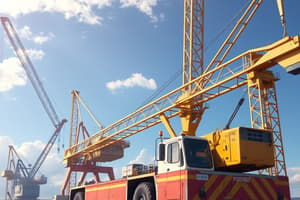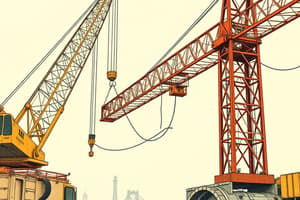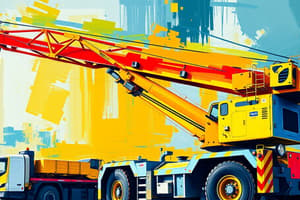Podcast
Questions and Answers
Which of the following is NOT a responsibility of the operator during the pre-use inspection?
Which of the following is NOT a responsibility of the operator during the pre-use inspection?
- Conducting a hydraulic fluid analysis (correct)
- Visually checking for signs of defect
- Reporting findings to maintenance personnel
- Ensuring the functionality of the crane
What primarily influences the frequency and extent of interim inspections?
What primarily influences the frequency and extent of interim inspections?
- Manufacturer's recommendations alone
- Industry-wide regulations only
- The operator's personal judgment
- Risk assessment procedures (correct)
Competence in carrying out pre-use inspections includes which of the following?
Competence in carrying out pre-use inspections includes which of the following?
- Formal certification from any entity
- Training and assessment (correct)
- Recent practical experience only
- Only theoretical knowledge of equipment
During the pre-use inspection, what should be prioritized before operating the crane?
During the pre-use inspection, what should be prioritized before operating the crane?
What type of inspection is typically performed during planned maintenance?
What type of inspection is typically performed during planned maintenance?
Which of the following components may be a focus during interim inspections?
Which of the following components may be a focus during interim inspections?
What is the correct condition for the operator's seat during checks?
What is the correct condition for the operator's seat during checks?
How should pre-use checks of cranes be conducted?
How should pre-use checks of cranes be conducted?
What does the term 'In-Service inspection' refer to?
What does the term 'In-Service inspection' refer to?
Which of the following must be confirmed regarding safety glass in the cab?
Which of the following must be confirmed regarding safety glass in the cab?
What is essential to check regarding the control functions and switches?
What is essential to check regarding the control functions and switches?
In terms of housekeeping in the cab, what is the primary requirement?
In terms of housekeeping in the cab, what is the primary requirement?
What should be verified about the swing brake during the checks?
What should be verified about the swing brake during the checks?
What is needed for the crane load charts in the operator cab?
What is needed for the crane load charts in the operator cab?
Regarding the cab's operational features, which of the following must function correctly?
Regarding the cab's operational features, which of the following must function correctly?
What should be checked regarding loose wires or panels in the cab?
What should be checked regarding loose wires or panels in the cab?
Which components should specifically be visually inspected for hydraulic system maintenance?
Which components should specifically be visually inspected for hydraulic system maintenance?
What is the primary purpose of examining the outrigger jacks and beams?
What is the primary purpose of examining the outrigger jacks and beams?
During the power and control cables inspection, which element is NOT typically assessed?
During the power and control cables inspection, which element is NOT typically assessed?
Which of the following devices should be included in the limiting and indicating devices check?
Which of the following devices should be included in the limiting and indicating devices check?
What critical aspect should be included in leak detection and management?
What critical aspect should be included in leak detection and management?
When performing P.T.O. operation checks, which system's functionality must be ensured?
When performing P.T.O. operation checks, which system's functionality must be ensured?
Which of the following is NOT part of a thorough examination of the crane's control system?
Which of the following is NOT part of a thorough examination of the crane's control system?
What should be checked to ensure the efficiency of outrigger examination?
What should be checked to ensure the efficiency of outrigger examination?
What is a primary characteristic of yard cranes?
What is a primary characteristic of yard cranes?
What distinguishes crawler mounted telescopic cranes in terms of inspection methods?
What distinguishes crawler mounted telescopic cranes in terms of inspection methods?
Which standards provide criteria for crane inspection alongside LEEA guidance?
Which standards provide criteria for crane inspection alongside LEEA guidance?
What major advancement has changed the way tracks of crawler mounted telescopic cranes are inspected?
What major advancement has changed the way tracks of crawler mounted telescopic cranes are inspected?
What is one of the primary functions of the strong platform on yard cranes?
What is one of the primary functions of the strong platform on yard cranes?
How do telescoping cranes mounted on tracks differ from traditional wheeled cranes during inspection?
How do telescoping cranes mounted on tracks differ from traditional wheeled cranes during inspection?
Why might yard cranes need outriggers despite being designed for yard use?
Why might yard cranes need outriggers despite being designed for yard use?
What is one challenge regarding the inspection of cranes mentioned in the guidelines?
What is one challenge regarding the inspection of cranes mentioned in the guidelines?
What is the main reason for maintaining cleanliness in the inspection area?
What is the main reason for maintaining cleanliness in the inspection area?
Which of the following items is NOT recommended to carry for inspecting mobile cranes?
Which of the following items is NOT recommended to carry for inspecting mobile cranes?
What precaution should be taken when testing a crane for 'lift on rubber' duties?
What precaution should be taken when testing a crane for 'lift on rubber' duties?
Why is it important to adhere to data sheets and chemical warnings when using cleaning materials?
Why is it important to adhere to data sheets and chemical warnings when using cleaning materials?
Which statement accurately reflects the safety protocols during a crane inspection?
Which statement accurately reflects the safety protocols during a crane inspection?
What should be included in a crane manufacturer's load rating chart for 'on rubber' lifts?
What should be included in a crane manufacturer's load rating chart for 'on rubber' lifts?
What is the purpose of lifting on rubber for rough terrain cranes?
What is the purpose of lifting on rubber for rough terrain cranes?
What should be assessed in the crane area before proceeding with the inspection?
What should be assessed in the crane area before proceeding with the inspection?
What is the primary requirement for the crane's positioning during a thorough examination?
What is the primary requirement for the crane's positioning during a thorough examination?
What is a primary reason manufacturers might not recommend routine overload testing?
What is a primary reason manufacturers might not recommend routine overload testing?
Which requirement must be verified regarding the crane's identification before the examination?
Which requirement must be verified regarding the crane's identification before the examination?
Which situation is generally accepted as a valid reason for performing an overload test?
Which situation is generally accepted as a valid reason for performing an overload test?
What must be ensured regarding access to the crane during a thorough examination?
What must be ensured regarding access to the crane during a thorough examination?
What potential consequence is highlighted if a crane fails during overload testing?
What potential consequence is highlighted if a crane fails during overload testing?
Why is it important to ensure the crane is clean before the examination?
Why is it important to ensure the crane is clean before the examination?
What should the examiner check regarding the crane's maintenance history?
What should the examiner check regarding the crane's maintenance history?
Which underlies the recommendation against routine overload testing by authoritative bodies?
Which underlies the recommendation against routine overload testing by authoritative bodies?
What should be thoroughly examined before applying a load to a crane during testing?
What should be thoroughly examined before applying a load to a crane during testing?
What is the function of personal protective equipment (PPE) in the context of crane examinations?
What is the function of personal protective equipment (PPE) in the context of crane examinations?
Why can repeated overload situations be problematic according to crane operation standards?
Why can repeated overload situations be problematic according to crane operation standards?
What must be included in the documentation reviewed by the competent person during the examination?
What must be included in the documentation reviewed by the competent person during the examination?
Which of the following is NOT a recommended action prior to a thorough crane examination?
Which of the following is NOT a recommended action prior to a thorough crane examination?
In preparing for a test on a mobile crane, what is the first step that must be undertaken?
In preparing for a test on a mobile crane, what is the first step that must be undertaken?
Which factor is NOT listed as a circumstance under which overload testing may be considered necessary?
Which factor is NOT listed as a circumstance under which overload testing may be considered necessary?
Which feature must be confirmed to ensure proper visibility for the operator?
Which feature must be confirmed to ensure proper visibility for the operator?
What indicates that the swing brake is functioning correctly during inspections?
What indicates that the swing brake is functioning correctly during inspections?
What is essential about the operator's seat during the inspection process?
What is essential about the operator's seat during the inspection process?
Which of the following must be present in the operator cab for safe crane operation?
Which of the following must be present in the operator cab for safe crane operation?
What characteristic of the cab's glass is crucial for safety checks?
What characteristic of the cab's glass is crucial for safety checks?
Which condition must the lights and windscreen wipers be in before operating the crane?
Which condition must the lights and windscreen wipers be in before operating the crane?
What must be true about the control functions during inspection?
What must be true about the control functions during inspection?
Which aspect is essential for the tilt cab mechanism inspection?
Which aspect is essential for the tilt cab mechanism inspection?
Study Notes
Mobile Crane Safety and Inspections
- The chassis and tyres are crucial for mobile crane safety; they require thorough examination.
- Key components to inspect include:
- Manufacturer’s information plate/label and duty charts
- Tyres, wheels, and axle locking systems
- Crane chassis, crawler tracks, and outrigger jacks with beams
- Braking systems, bolts, pins, and fastenings
- Slew section structure and slew mechanism, with full movement checks
- All piping, hydraulic cylinder fittings, and oil/fluid levels
- Superstructure, jib, fly jib, and all pivoting joints
- Wire ropes, pulleys, sheaves, drum guards, and counterweight systems
- Limiting devices like rated capacity systems and anemometers
Levels of Crane Inspection
-
Pre-use Inspection:
- Conducted by the operator to check for defects or operational safety.
- Involves visual checks and functionality assessment; issues must be reported for further inspection.
- Competence in conducting these checks is essential, relating to training and assessment.
-
Interim Inspection:
- Focuses on critical components that may deteriorate before the next thorough examination.
- Frequency is determined by risk assessments and manufacturer's recommendations.
- Often conducted during planned maintenance or after repairs.
Operator and Cab Controls
- Cab cleanliness and organization must be maintained, ensuring no obstructions.
- Operator’s seat must be functional and in good condition.
- Inspect for loose wires, functional RCL, presence of load charts, and clarity of control markings.
- Ensure safety and operational effectiveness of swing brakes, tilt mechanism (if applicable), lights, and other controls.
- Both windscreen wipers and air conditioning/heating systems should operate correctly.
Crane Controls
- All control functions and switches must be clearly marked and responsive as indicated.
- Regular checks are essential for safe and efficient crane operation.
Cleaning Materials
- Ensure the inspection area is clean to prevent contaminants from obscuring any equipment damage or deterioration.
- Carry basic cleaning supplies, such as rags, wire brushes, and pH neutral cleaning fluids, to clean inspected components as necessary.
- Adhere to chemical safety data sheets and ensure risk assessments include cleaning materials.
Types of Mobile Cranes
Rough Terrain Cranes
- Designed for rough terrain; capable of "lift on rubber" where lifting and traveling occur simultaneously.
- Safety precautions require outriggers to be extended and jacks clear of the ground during function testing to prevent risks from tire failure.
Yard Cranes
- Suitable for yard applications where outriggers may not be practical; can operate on rubber.
- Designed to transport light loads like pumps and motors, providing a stable platform.
Crawler Mounted Telescopic Cranes
- Used for on-site operations; easier to inspect due to hydraulic drive systems.
- Inspection procedures are similar to wheeled cranes, with attention to the undercarriage.
Types of Examination
- Adhere to BS7121-2-1 and BS7121-2-3 standards for thorough crane inspections.
- ISO9927-1 and ISO9927-5 provide similar guidelines for crane examinations.
Preparation for a Thorough Examination
- Safety: Position cranes in safe areas for inspection.
- Lighting: Ensure well-lit inspection environments or use portable lights if necessary.
- Cleanliness: Cranes should be clean to avoid concealing defects; examiners should not be responsible for cleaning.
- Access: Establish safe access for inspection personnel, using suitable platforms and ensuring workers are trained for equipment use.
- Identification: Verify ID and capacity markings against crane records, legal documents, and previous inspection reports.
- History: Review past inspection reports and maintenance logs for recorded defects or alterations.
Load Testing Mobile Cranes
- Consult manufacturers for advice on testing methods and load magnitudes before starting.
- Conduct visual examinations of cranes and testing areas prior to load application.
- Ensure proper rigging based on the manufacturer’s instructions is verified during examinations.
Operator and Cab Controls
- Ensure cab cleanliness, with no clutter, and that operator controls are fully functional.
- Check the operational condition of the operator’s seat, RCL, and crane-specific load charts present in the cab.
- Ensure unobstructed operator views and that safety glass is used without unauthorized modifications.
- Confirm that all switches are clearly marked and operational, including the swing brake and tilt cab mechanism.
- Verify the functionality of lights, windshield wipers, and air conditioning/heating controls.
Studying That Suits You
Use AI to generate personalized quizzes and flashcards to suit your learning preferences.
Related Documents
Description
This quiz focuses on the critical components involved in the safety examination of mobile cranes. It covers aspects such as manufacturer information, tyres, wheels, and chassis integrity. Understanding these components is essential for ensuring the safe operation of mobile crane systems.




